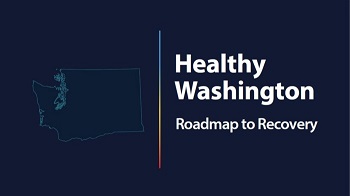What does Governor Inslee's 'Healthy Washington—Roadmap to Recovery' Mean for Employers?
By Krista Nelson Slosburg | Related Practice: Employment
Category: Covid-19
On January 5, 2021, Governor Inslee announced a new phased COVID-19 recovery plan for Washington state. The plan is effective January 11.
The new plan divides the state into eight regions, includes new criteria for Phases 1 and 2, and establishes new metrics the Department of Health will use to determine whether a region can advance phases. The metrics for each region will be updated on the state’s Risk Assessment Dashboard every Friday, and depending on those metrics, regions may move into a new phase—forward or backward—on the following Monday. 
The eight regions are as follows:
- Central: King, Pierce, Snohomish
- East: Adams, Asotin, Ferry, Garfield, Lincoln, Pend Oreille, Spokane, Stevens, Whitman
- North: Island, San Juan, Skagit, Whatcom
- North Central: Chelan, Douglas, Grant, Okanogan
- Northwest: Clallam, Jefferson, Kitsap, Mason
- South Central: Benton, Columbia, Franklin, Kittitas, Walla Walla, Yakima
- Southwest: Clark, Cowlitz, Klickitat, Skamania, Wahkiakum
- West: Grays Harbor, Lewis, Pacific, Thurston
The metrics include: (1) trends in two-week rates of COVID-19 cases per 100,000; (2) two-week trends in COVID-19 hospital admission rates; (3) ICU occupancy; and (4) COVID-19 test positivity rates. To move forward from Phase 1 to Phase 2, regions must meet all four of the applicable metrics. To remain in Phase 2, regions must meet at least three of the applicable metrics. Regions that advanced to Phase 2, but fail to meet two or more of the applicable metrics at a later date, will be moved back to Phase 1.
What does this mean for your business?
- Professional Services Corporations: Effective January 11, professional services corporations are no longer operating under the Governor’s previous directive, when work from home was mandatory, if possible. In both Phases 1 and 2, remote work is “strongly encouraged” with in-office work allowed up to 25% of building capacity.
- Retail Stores: Effective January 11, retail stores are encouraged to offer curbside pick-up, but may operate at a maximum of 25% building capacity in both Phases 1 and 2.
- Eating and Drinking Establishments: Effective January 11, eating and drinking establishments in Phase 1 are prohibited from offering indoor dining, but are permitted to offer outdoor dining so long as they close at 11 p.m., limit capacity to six per table, and limit two households per table. In Phase 2, eating and drinking establishments will be allowed to resume indoor dining capped at 25% building capacity, and must maintain the 11 p.m. closure. Outdoor dining restrictions remain the same as Phase 1 with a maximum of six per table and limit of two households per table. Bars and clubs that only serve individuals over 21 and do not offer food must remain closed during both Phases 1 and 2.
- Indoor Recreation and Fitness Establishments: Effective January 11, indoor recreation and fitness establishments—like gyms, dance studios, personal trainers, and climbing gyms—are permitted to open for low risk sports with groups of no more than five during Phase 1. Appointment based fitness and training is allowed with 45-minute maximum sessions and no more than one customer per room or per 500 sq. feet for large facilities during Phase 1. In Phase 2, low and moderate risk sports competitions are permitted with no tournaments, and fitness and training activities will be permitted to operate at a maximum of 25% building capacity .
- Indoor Entertainment Establishments: Effective January 11, indoor entertainment establishments, like bowling alleys and indoor event spaces, may open for private rentals and tours for individual households in groups no more than six during Phase 1, with general admission prohibited. In Phase 2, they may open at 25% building capacity, with eating and drinking requirements applying to establishments that serve food and drinks.
- Outdoor Entertainment Establishments: Effective January 11, outdoor entertainment establishments, like outdoor event spaces and theaters, are allowed to open for ticketed events only in groups of ten with a limit of two households and timed ticketing required during Phase 1. In Phase 2, group size may increase to 15 with the same limit of two households per group, and the timed ticking requirement will be replaced with a maximum of 200 persons.
We recommend that businesses continue to operate under a Safe Work Plan that guides their reopening and includes specific protocols for things like social distancing, hygiene, and mask requirements and a plan if an employee becomes sick or has been in close contact with someone with COVID-19.
For questions, please contact a member of the Stokes Lawrence Employment Group.
